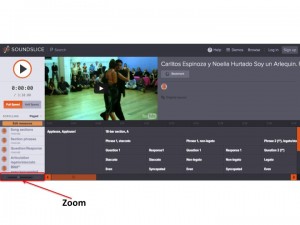Introduction
Hello, fellow tangueros!
For a while now I have been focusing on the musicality in my dancing. I would like to offer to your attention an especially detailed exercise that I took myself through – a worked example, an annotation of a single song danced by Noelia and Carlitos. You can see the annotated song below. Just zoom out using the slider in the lower-left corner: the default zoom level is too close-in. Notice that you can play the song in half-time, which really helps when watching the interplay between the footwork and the music.

Song structure
To help out with this section, please refer to http://www.tangomusicology.com (an independent resource), and in particular to the phrasing page:
http://www.tangomusicology.com/wordpres/structurequestion-and-answer-phrasing-an-overview/
This particular song consists of two basic sections, repeated, an 18-bar section (A) and a 20-bar section (B). The latter carries all the voice – this is a song for dancing with the singer, the great Charlo, singing only the refrain (see the following about the difference between the refrain and the orchestra singer:
http://www.tangology101.com/main.cfm/title/The-Role-of-the-Tango-Orchestra-Singer/id/946). At this level of annotation, the song looks like this:
ABA(voice)BA
Now let’s look at the sections.
Section A
Section A consists of three 6-bar phrases, the first two of which are repeats, and the third might be considered a very stylized repeat, so let’s call them phrases 1 and 2(or 1*). The overall structure of section A is:
1, 1, 2(1*)
Section B
Section B consists of two 8-bar phrases and one short phrase, a 4-bar that mirrors the first half of the first phrase of the section.
Numbering the phrases 3 and 4, the structure of this section is:
3, 4, 3*(first half, resolved)
The 6-bar phrases of section A and the 8-bar phrases of section B both neatly break down into question and response, except when they don’t: in section B, the last phrase is the question of phrase 3 but resolved so that there’s no need (and indeed no presence of) response.
For syncopation and beat annotation, I’ll refer you to the annotated video, and for more on music theory, as I have already mentioned, to http://www.tangomusicology.com/
Applying the annotation
Now that we have an annotated song (I take all the blame for any inaccuracies), what can we do with it? I’ll give several examples, mostly focusing on Carlitos’ use of linear vs circular movement. I’ll consider ambiguous movement to be decided by what the follower feels, rather than what the eye sees; that is, when Noelia is doing forward milonguero ochos, without any turning, in a circle around Carlitos, we’ll call it linear (but note the interesting goings-on). Before getting into the details, note that both the lead and the follower roles here are executed with a lot of complexity and with multiple layers. I’ll stay away from the follower part altogether, because it’s ‘above my paygrade’, but I will say that there’s a whole lot going on with presence/absence of embellishments that can be gleaned even from my relatively superfluous analysis. I have not annotated Noelia’s footwork, except where her movement is twice slower or faster than Carlitos’, or where she does traspie, but both of those are led elements and should not be considered adornos.
Linear vs Circular movement
So, let’s talk about linear vs circular movement. Depending on
‘what the music does’, one can lead circles (giros, molinettes, etc) or lines (walks, ochos cortado, etc). One can lead either, but what to lead when? Ok, all leaders are taught pretty early that it’s probably nice to lead circles in vals. Watch an old (or new) video with Viennese Waltz and you’ll see why. Some older tango valses, especially Canaro’s, do sound very Viennese, and may have been meant that way from Canaro’s time in Europe. However, is there any reason to lead lines vs circles in tango?
The tango in question, Lomuto’s version of ‘Soy Un Arlequin’, is an old piece, written by Discepolo in 1929, pre-golden age, probably to go with strong guitar sound (diminished or absent here, I can’t quite tell). This version was probably arranged in that time frame as well, but its arrangement was more modern than most tangos of its time, and probably more modern than the song was intended for by Discepolo. The song has a great mixture of rhythmic and melodic phrases and of staccato through legato articulation.
I have created several tracks that help to understand both the music and the movement. The tracks relevant to the question of circular vs linear movement are:
Direction of travel (circular, linear)
Articulation (legato, non-legato, staccato)
Beat (even, syncopated)
Question/response phrase annotation
Do the last 3 elements (articulation, Beat, QR) have anything to do with Carlitos’ choice of direction of travel? Is that one of the tools that he uses to ‘annotate’ the music?
Let’s do some tabulation of how often different music elements occur with linear vs circular leads (hopefully I haven’t made any counting errors):
Conclusion: staccato articulation is always linear; legato is predominantly circular; non-legato is predominantly linear, at least in this very rhythmic song.
Other examples
Conclusion: Even beat is usually linear (just walk). Syncopated can vary.
Conclusion: It is obvious that Carlitos tries to lead a question and response phrase in the same style of walking (although frequently there’s a difference in syncopation articulated by a traspie)
Let’s finish by noting that linear vs circular decision depends on these three elements JOINTLY. That type of analysis is beyond the scope of my examples.
Homework
As homework, consider: what drives Carlitos’ decision to lead a traspie? to lead 1/2x, 1x, or 2x the tempo of the driving beat? Hopefully my annotation of this song makes it easier to ask these questions.


Could you tell me what theme are you using on your site?
It looks nice.